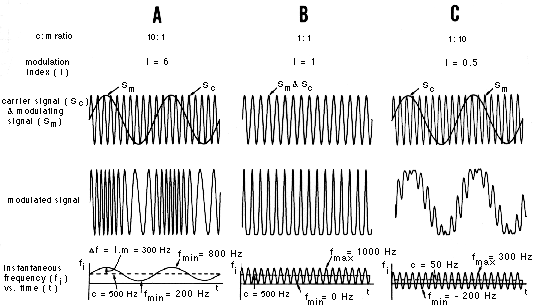The process of varying the FREQUENCY of a signal, often PERIODICally. An example of FM is the violinist's VIBRATO, where the length of a string (and therefore the resulting pitch) is rapidly altered by a fast oscillating movement of the finger and wrist.
Compare: AMPLITUDE MODULATION, FLUTTER, MODULATION, TRILL, WOW.
In radio TRANSMISSION, the process involves the MODULATION of a CARRIER wave's frequency by the program signal being transmitted. See also: MODULATED CARRIER.
By analogy to the radio sense of the term, frequency modulation is used in electronic and computer SOUND SYNTHESIS to refer to a similar process where both the carrier and modulating signals are in the audio range, or the latter in the SUBAUDIO range. If both are pure SINE TONEs, then the SPECTRUM produced consists of the carrier frequency c plus pairs of SIDEBANDs equally spaced about the carrier at a frequency distance equal to the modulating frequency m. The spectrum may then be described as:
In this expression, the + indicates the upper sidebands, and the - indicates lower ones, which if producing a negative frequency appear as a positive frequency component with a PHASE SHIFT of 180°.

If the modulating signal is 8 Hz or lower, the result of the modulation is a vibrato, whereas above about 20 Hz, the TIMBRE of the tone is changed. In between these two frequencies, a transition from one effect to the other occurs. If the carrier consists of other PARTIALs, then pairs of sidebands are produced about each of them, creating a much more complex spectrum. Generally, the process is used for timbral synthesis.
The strength of the sidebands depends on the MODULATION INDEX, which is the ratio of the amplitude to the frequency of the modulating signal. (Note that the amplitude of the modulating signal equals the maximum frequency deviation Df of the resulting wave.) That is, the stronger the amplitude of the modulating signal, the greater the number of sidebands which contribute significantly to the spectrum. Mathematically, the amplitude of the nth sideband is given by the nth order Bessel function for the given modulation index.
Time-dependent spectra may be produced by varying the modulation index during the course of the sound. Most percussion-like sounds are characterized by a strong spectrum activated during the ATTACK, which then dies away during the DECAY; this may be approximated by a sharp rise in the modulation index followed by a slower decay. The time behaviour of the index, therefore, controls the spectral envelope of the sound (see SPECTRUM).
Ref.: J. Chowning, "The Synthesis of Complex Audio Spectra by Means of Frequency Modulation," Journal of the Audio Engineering Society, vol. 21, pp. 526-34, 1973.

Three examples of frequency modulated signals, where (A) the carrier frequency is higher than the modulating frequency (c:m = 10:1), (B) both frequencies are equal, and (C), the modulating frequency is higher than the carrier (c:m = 1:10). The graph below each modulated signal shows the instantaneous frequency during the course of the modulation. Negative frequencies as shown may be considered as equivalent to positive frequencies with a phase shift of 180°.
![]() Sound
Example: FM example A
(above).
Sound
Example: FM example A
(above).
Sound Example: FM example B (above).Sound Example: FM example C (above).
For a more detailed account of the properties of FM spectra, consult the FM Tutorial.
home